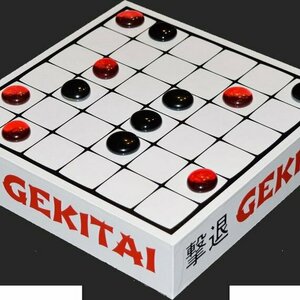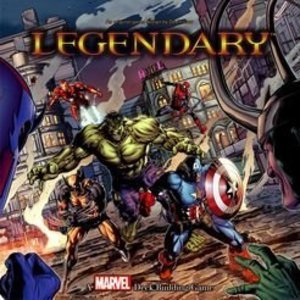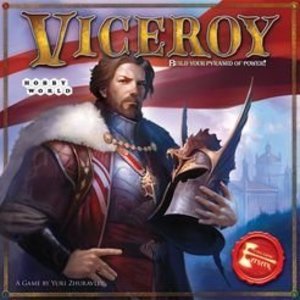
Island Tribe 2
Games and Entertainment
App
Get ready for new adventures in the second part of the Island Tribe iPhone series! Be one of the...

Barbie™ Sparkle Blast™
Games and Entertainment
App
Travel the world with Barbie and her friends! Solve puzzles to unlock new adventures and stylish...

Dinosaur Island
Tabletop Game
In Dinosaur Island, players will have to collect DNA, research the DNA sequences of extinct dinosaur...
Boardgames JurassicParkTheBoardgame BooksintoGames WorkerPlacementGames
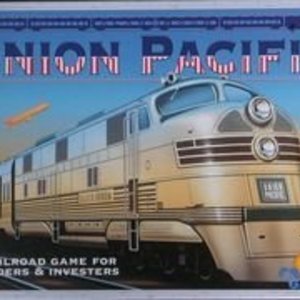
Union Pacific
Tabletop Game
Union Pacific is a train-themed stock market game. On each turn, players must choose between...
BoardGame TrainGame PuffingBilly
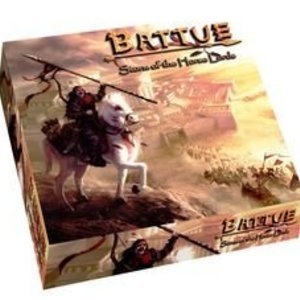
Battue: Storm of the Horse Lords
Tabletop Game
Rooted in the World of Terris, a brutal, dark fantasy setting envisioned by authors Robin Laws and...

A Woman’s Self-Love
Book
How to develop Self-Love in five easy steps, even if you failed at every other self-help strategy. ...
self-help

Bratva's Intern (Bratva's Undoing #1)
Book
They call me a businessman. And that suits me fine. Let them believe I built my empire with...
Contemporary MM Mafia Romance
Purple Phoenix Games (2266 KP) rated Gekitai in Tabletop Games
Feb 20, 2020
Gekitai is an abstract strategy game with very minimal rules. The phrase, “easy to learn, but hard to master” is very overdone, but it certainly applies here. For those that are wondering, the term, “Gekitai” is Japanese for “Repel.” You will see why this nomenclature is perfect for this game soon.
DISCLAIMER: We were provided a prototype copy of this game for the purposes of this review. Though I know the designer personally, I will be reviewing this game as an impartial judge. -T
Normally I like to include setup instructions here in this paragraph for my reviews, so I shall do that now. To setup, place the board between the two players and give each player their eight matching pieces. In my game, they are red and black glass beads. For convenience I will refer to the red ones as apples and the black ones as 8-balls. That’s it. You’re setup to play.
The object of Gekitai is to fulfill one of two victory conditions: play until one player has three of their pieces in a row (diagonally OR orthogonally) or finish their turn with all eight of their pieces on the board. Easy, right? It most certainly is! Oh, you want the catch? Ok then, here’s the catch: while players can place any piece on any empty square, once placed the pieces will repel all other adjacent pieces away from itself. This includes their own pieces.
So let’s say you start the game and place your first 8-ball in a corner closest to you. Great opening noob. I mean move. You see, I would just place one of my apples adjacent to your 8-ball and repel it right off the board. That doesn’t mean that I have captured your 8-ball or anything like that. You would be able to use it again next turn if you like, but this is the danger of outside spaces. When repelled, a piece (your 8-ball) continues one space in the direction away from the most recently-placed piece (my apple). So diagonally if diagonal from the just-placed apple, or orthogonally otherwise. Again, this would affect all pieces that are adjacent, not just your opponent’s. Think of placing a piece as someone doing a cannonball in an infinity pool. Everyone already in the pool will get pushed away from the point of impact and may even fall out of the pool, but be able to hop back in soon.
One note about pushing other pieces. One piece can only push one other piece. Here’s what I mean. When my apple is placed near another 8-ball or apple, it repels it, right? Well, a piece may only be repelled if there is an empty space for it to go. If another apple is blocking the pathway of an affected apple or 8-ball, no movement happens. The pieces has been blocked. In this way strategy plays in integral part in Gekitai – you must always be thinking about 10 turns in the future. Play continues in this fashion until a player has achieved three-in-a-row or placed all of their pieces on the board.
Components. Again, we are playing with a PNP prototype game package. Granted, this PNP is assembled by the designer and looks WAAAY better than if I had tried to assemble it myself, so we do take that into consideration. Components aside (because unless you order a copy from the designer via Etsy in the future, you will probably download the files and play on a sheet of paper with coins or other stand-ins), this is a typical, classic abstract strategy-style game. The board can look any way you like in a 6×6 board and you can you use any bits for your game. Heck, you could even play with real apples and 8-balls. But what we were provided is excellent and looks great on the table.
But gameplay. Like I mentioned earlier, I know the designer and his family and they are wonderful people. Luckily that makes no difference here because the game itself is absolutely wonderful! My wife typically kicks my booty in all abstracts. Ok fine, usually in all games. BUT! After playing Gekitai lots with her, she has only beaten me once! When we do play it she asks for rematches several times over and I just love being able to have a go-to game for when we have a few minutes between running around with the kids. I love it. She loves it. We at Purple Phoenix Games, with an enthusiastic guest score from my wife, give Gekitai a cannonball-esque 11 / 12. We suggest you go to the BGG page where the PNP files can be printed. You will want this in your collection.
Purple Phoenix Games (2266 KP) rated Legendary: A Marvel Deck Building Game in Tabletop Games
Sep 19, 2019
In an era where superheroes are the norm, the days of petty crime are over. As the protectors of our world have grown in power, so too have those who would see it fall to chaos. Out of the shadows comes a nefarious Mastermind who has engineered the most wicked evil scheme the world has ever seen. With an ever-growing band of followers and henchmen to carry out the plot, the future looks dismal. But do not fear – the supers are here! This job is way too big for only one single hero to handle, but if they all band together, then maybe, juuuust maybe, they might be able to pull it off…
DISCLAIMER: There are several expansions to this game, but we are not reviewing them at this time. Should we review them in the future we will either update this review or post a link to the new material here. -T
Set in the world of Marvel comics and, recently, the Marvel Cinematic Universe, Legendary: Marvel is a cooperative deck building game. Players take turns drafting and playing cards to recruit heroes to their team and to fight off the villains trying to carry out the sinister scheme. You have to strategize how you want to build your deck to best complete the mission – do you recruit heroes that give you special abilities (like drawing additional cards), or do you recruit strong heroes that give you lots of attack points? The choice is entirely up to you! Although all players are building their own individual decks, you must also devise a team strategy because all players either win or lose together as a team. That being said, there is a small competitive aspect to this game – the player with the most Victory Points (earned by defeating villains and rescuing bystanders) is deemed the most legendary hero of the game! Exactly how competitive the game gets is up to the players. I personally prefer a more cooperative approach and usually don’t tally up VPs at the end of the game – either the team won or we lost.
The beauty of this game is that it can be played with any combination of Marvel characters – you are not limited to only using specific teams. Selecting which heroes/villains/Mastermind/etc. to use is at the discretion of the players. Want Iron Man to team up with Deadpool and Wolverine to fight off Kingpin? Go for it! You have basically the entire Marvel universe from which to choose, so the sky is the limit! With so many options, though, it can be a little overwhelming, so I usually use a randomizer app to create a setup for me. Sometimes the setup itself will determine how the entire game will play out – certain combinations of Mastermind/villains/scheme can be BRUTAL to play and difficult to win. But the cool thing about this game is that you cannot just look at a setup and tell if it will be difficult or not – that realization only will come once you start playing!
I love playing this game because of its immense variability – the base game alone has 500 cards! The ability to choose your own heroes, villains, Masterminds, and Schemes means that you will probably never play the same game twice. And on top of that, Legendary: Marvel currently has like 19 expansions! The possibilities are truly endless, and that is the Holy Grail for me when it comes to gaming. I know that I will never get bored of this game because it is a different experience every game.
On the flip side, my main grievance with Legendary: Marvel is with the physical setup and teardown. Every play uses SO MANY cards that it does take a decent amount of time to get setup or put away. Every individual hero/villain/Mastermind/etc. must be sorted and stored separately, and with 500+ cards, that time adds up. When deciding on a game to play, sometimes I skip Legendary: Marvel because of the time it takes to set up. I LOVE to play it, but sometimes I do not feel like taking that much time to set up – I just want to play! My other grievance deals with certain hero superpowers/special card text. Some hero cards have special text, and the definitions are outlined in the rule book but not on the cards themselves. Until I learned/memorized what that special text meant, I was constantly referring back to the rule book nearly every turn to make sure I was using the cards correctly. There is a bit of a learning curve with some of the hero text, but it does get better the more you play!
Don’t let the simplicity of the mechanics fool you – this game requires more strategy than meets the eye! You must not only decide on a strategy for building your individual deck, but you and your teammates must also collectively choose a group strategy to defeat the Mastermind. Cooperation is key, and it really helps the theme of the game come to life. Definitely a winner for Purple Phoenix Games with a butt-kicking 24 / 24 and a well-earned Golden Feather Award!
Purple Phoenix Games (2266 KP) rated Viceroy in Tabletop Games
Jun 12, 2019
Power. That’s what everyone wants, isn’t it? Well, at least it is in Viceroy! As an inhabitant of the world of Laar, you are fighting to become the ultimate ruler. Recruit allies who provide strategic advantages and enact laws that solidify your claim for power. Do you have what it takes to build and maintain a powerful kingdom, or will your attempts fall short?
DISCLAIMER: There is an expansion to this game, but we are not reviewing it at this time. Should we review it in the future we will either update this review or post a link to the new material here. -T
Viceroy, a game of card drafting and tile placement, is played over 12 turns in which players build a pyramid with their cards – paying to place each card and collecting rewards based upon which level of the pyramid a card is placed. Each turn is divided into two phases: Auction and Development. During the Auction Phase, players bid gemstones to buy a card from the auction line. Once every player has either collected 1 card from auction or passed, play moves to the Development Phase. During the Development Phase, players can either play a card into their pyramid, pass, or discard a card and take 2 gemstones from the reserve. To play a Law card into your pyramid, you place it for free. To play a Character card into your pyramid, you have to pay for it with gems. The cost is dependent upon which level of the pyramid the card is to be placed. You must pay for the level the card will sit on, as well as pay the cost for every level beneath it. For example, to add a card to the third level of the pyramid, you must pay the cost for the 3rd level, AND 2nd level, AND 1st level. The rewards gained from adding a card to the pyramid, however, are taken only for the level on which the card sits. In the earlier example, you would only get the reward for the third level alone, since that is the level on which the card sits. The Development Phase is played over 3 rounds, so a player could play up to 3 cards into their pyramid during 1 Development Phase. After the 3 rounds are up, the next turn begins again in the Auction Phase. When all cards are gone from the Auction Deck, the game ends. Players count up all of their Power Points, and the player with the highest Power value wins!
The only change in Viceroy between a group and solo game is during the Auction Phase. Obviously, if you are playing solo, there is nobody to bid against for cards. How that is alleviated is that you still bid your gemstone as normal, and you randomly draw an unused gemstone from the box as an AI bid. If the colors match, you lose your gem and go on to the next auction. If the colors do not match, you collect your choice card, and the card the AI would have collected gets discarded. If the AI color does not match an available card, you just discard one of the remaining cards. This mimics group play in the sense that you might not always get the card you want from auction! The Development Phase is played as normal. At the end of the game, count points as normal and try to beat your own high score.
Viceroy is a neat game. Every card has so many options that there is no one single strategy that is a sure-win every time. Maybe one game I’ll go for Magic tokens. And maybe the next I’ll try to go for raw Power Point tokens. The possibilities really are endless, and that keeps this game fresh for me. I don’t feel like I’m just going through the motions because every card will act differently depending on where it is played. Strategy really is everything here. On the flip-side of that, however, is that sometimes the options can be a little overwhelming. With so many possibilities for each card, it can get hard for me to decide on what strategy I really want to use. It should also be noted that a card can only be played onto a level if it can sit on exactly 2 cards on the level beneath it. So sometimes I buy a card to play on a certain level only to get to the Development Phase and realize I don’t have a legal place to which I can play it. So do I sacrifice other cards/gemstones to build a slot for this one card, or do I play it to a different level and change my strategy a bit? There’s a little bit of a learning curve, but the more I play, the better I get (or at least, the better I think I get).
Another grievance with Viceroy is that I find myself running out of cards in my hand a lot. The only opportunity to draw cards is if you play a card into your pyramid that allows you to do so. And since I’m usually focused on other strategic routes, I don’t use those cards for those purposes. So then I play all of the cards in my hand (leaving me empty-handed), get 1 card at the next auction, play it, and am again left with no cards in my hand. To fix this issue, I wish one of the actions you could take during the Development Phase was to draw 1 card. I’m not sure if other people have this issue, or if it’s just me, but it’s a problem I run into almost every game.
Overall, I think Viceroy is a good game. It’s unique in the sense that there are so many possibilities that you’ll probably never play the same game twice, even if you decide to play by the same strategy. The mechanics and gameplay are cool too – it’s fun to watch your pyramid literally grow in front of you as the game progresses. This game takes a little more focus and thought than you might think, so it’s not one I’d necessarily just pull out for some light fun. I think Viceroy is as exciting as a solo game as it is as a group game since there really aren’t any differences between the two settings. If you like Viceroy, give it a try solo! If you’ve never played Viceroy, try it either solo or in a group – it’s the same game after all!
https://purplephoenixgames.wordpress.com/2019/04/18/solo-chronicles-viceroy/
